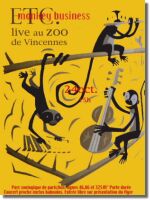 October
24th 2008: live in the Parisian ZOO ... :: On friday afternoon, the
parisian
zoological garden (Zoo de Vincennes) offers its baboons a special performance
by Anthony (aka Carcone), Har$, Rébus and Jean Bordé in: "Monkey Business" ... Entrance is FREE upon presentation of the event's FLYER ...
October
24th 2008: live in the Parisian ZOO ... :: On friday afternoon, the
parisian
zoological garden (Zoo de Vincennes) offers its baboons a special performance
by Anthony (aka Carcone), Har$, Rébus and Jean Bordé in: "Monkey Business" ... Entrance is FREE upon presentation of the event's FLYER ...
"In his keynote 'Modern, Postmodern, Altermodern?' Nicolas Bourriaud,
art critic, former director of the Palais de Tokyo in Paris, and curator
of the fourth Tate Triennal to be held in 2009 at the London Tate Gallery,
stated that artists are looking for a new modernity, based on translation.
What matters, he says, is to translate the cultural values of cultural groups,
and connect them to the global network ... For this new modernity, that
will mark the end of postmodernism, Bourriaud coined the term 'altermodern'
: it describes art made in today's global context, which is a reaction agains
standardisation and commercialism ... In 'Monkey business' four postmusicians
herald the death of postmodernism and the subsequent transition of today's
art into a new altermodern era, in an exclusive freely improvised - and
instantaneously translated - acoustic performance near, with and for the
group of baboons that are living on the Zoo's monkey rock ..." ETC.
(oct. 15th, 2008)
[ Read about what happened in the zoo, in
Monkey Business,
etc... ]
Hanna's Sirens
(Tuned City, Berlin _o)
october 12, 2008.
Wikipedia, at least at the time that I was writing this entry, left little, but still: some, doubt about what a siren is: "A siren," it told us, "is a loud noisemaker." Lest we not mistake the average noise act for a siren, the Britannica Online Encyclopedia is more precise, and adds that a siren's"strident sound results from the high number of overtones", and that it produces "a piercing sound of definite pitch".
I think that is much better. What do you think?
The first siren was built by the scottish physicist and inventor John Robison. In 1799 he constructed a stopcock (an externally operated valve) that shut and opened the passage of a pipe 720 times in a second. It was fitted to the windchest of an organ, that enabled him to blow air into the pipe. So Robison's siren actually was - potentially - (part of) a 'mechanical music' device. He described his experiments and the 'noises' they brought forth in the 3rd edition of the Encyclopaedia Britannica, which was published in that same year, 1799. Robinson's text is cited in John Tyndall's 'Lectures on Sound', published in 1867 (four years after von Helmholtz's seminal 'On the Sensations of Tone'). Tyndall describes Robison's work in his second lecture, in the third paragraph ('Musical sounds produced by puffs'): "The sound [...] was most smoothly uttered, equal in sweetness to a clear female voice. [...] When the sound was reduced to 360, the sound was that of a clear, but rather a harsh man's voice. [...]" (The second paragraph of Tyndall's second lecture is called: 'Musical sounds produced by taps'.)
 The
siren was given its name by the french physicist and engineer Charles
Cagniard de la Tour, who - in 1819 - instead of a stopcock and a pipe
used a disk with evenly spaced holes around its edge. The disk rotates at
high speed, and interrupts at regular intervals a jet of air, directed at
the holes. It is this type of siren that one finds depicted in the first
drawn images of the devices, like in Helmholtz's 'On the Sensation of
Tone'.
The
siren was given its name by the french physicist and engineer Charles
Cagniard de la Tour, who - in 1819 - instead of a stopcock and a pipe
used a disk with evenly spaced holes around its edge. The disk rotates at
high speed, and interrupts at regular intervals a jet of air, directed at
the holes. It is this type of siren that one finds depicted in the first
drawn images of the devices, like in Helmholtz's 'On the Sensation of
Tone'.
The sound of sirens became the one sound most emblematic of the new, industrial age. Factories that, like fungi, began infecting cities worldwide, employing ever more workers drawn in from the country-side, used sirens to indicate the start and the end of a working day or period. Throughout much of the twentieth century sirens were the default devices employed to summon (volunteer) firemen in case of a fire alarm. And as soon as public services (police, fire brigade, ambulance) began to use motorized cars as their principal means of transport, these 'emergency vehicles' came equipped with sirens to signal their approach and priority ...
As a sign & symptom par excellence of modern times, the sound of sirens (the sounds of sirence) could not but enter the work of composers that sought to create a music reflecting these times. In an entry earlier this year I mentioned The Symphony of Factory Sirens (1923), by russian composer Arseny Avraamov. Also springs to mind, from about the same time, George Antheil's Ballet Mécanique. But most prominently featured we find the siren in the work of Edgar Varèse. It was, for example, again in 1923, that New York saw the premiere of his Hyperprism, a short piece scored for a small ensemble, lots of percussion and a siren. As critic Paul Rosenfield later re-called, it was in particular a piercing note emitted by the siren that during the performance evoked much 'nervous laughter' from the audience, who must have recognized the sound, but clearly at that time was not quite ready yet to accept a siren in the context of a music-hall ... ( * )
Sound of course has always been the one means able to instantaneously attract the attention of large groups of people. It was sound that from earliest ages one was used not only as a means of warning, but also as a way to regulate life within communities. In the pre-industrial western world, before the invention of the siren, warning and regulation came typically from the ringing of large bells, suspended in the towers of churches and otherwhere. Even though the ringing of bells is still applied as a signaling device in (very) small communities (villages), large cities and metropolitan areas warn its population in case of pending disaster by activating a network of powerful sirens, designed so as to penetrate as large an area as possible.
The 'civil defense siren' entry at Wikipedia's (which I found particularly informative and well-researched) includes an overview of the different types of sirens that were and are in use as part of public warning systems in different parts of the world.
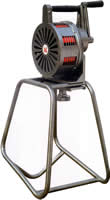 Most
modern air-based (pneumatic) sirens do not use disks, but two concentric
cylinders, with vertical slots. On the web site of Sirens,
Horns & Hooters Pty Ltd, an 'australian owned manufacturer
of a range of industrial quality noise making devices', I found besides
a selection of the currently predominant electro-mechanic and electronic
sirens a couple of nice examples of such 'sirenic' aerophones,
powered by hand. (Btw, being able
to activate an alarm without needing electricity in whatever form,
in some 'situations' will be a sine-qua-non ...) In the picture
you see the
LK120-model. Among its proposed applications are that as a shark
alert for surf clubs, and the use in schools and kindergartens, as
a signal for a lock
down ( ** ). It signals at 400 Hz, with a sound
pressure of 120 dB at a distance of 1 meter, and a "recognizable siren
sound associated with the 'air raid' warning type sound" ...
Most
modern air-based (pneumatic) sirens do not use disks, but two concentric
cylinders, with vertical slots. On the web site of Sirens,
Horns & Hooters Pty Ltd, an 'australian owned manufacturer
of a range of industrial quality noise making devices', I found besides
a selection of the currently predominant electro-mechanic and electronic
sirens a couple of nice examples of such 'sirenic' aerophones,
powered by hand. (Btw, being able
to activate an alarm without needing electricity in whatever form,
in some 'situations' will be a sine-qua-non ...) In the picture
you see the
LK120-model. Among its proposed applications are that as a shark
alert for surf clubs, and the use in schools and kindergartens, as
a signal for a lock
down ( ** ). It signals at 400 Hz, with a sound
pressure of 120 dB at a distance of 1 meter, and a "recognizable siren
sound associated with the 'air raid' warning type sound" ...
That finally brings me to what I actually wanted to talk about ...
The national alert systems using networks of sirens that these days are in use in most european countries, had their origin in the air raid warning systems that were installed there in the years preceding the second world war. Therefore in the Netherlands, for example, it still is called: luchtalarm. The system proved its use and effectiveness during those years of war. And because that war did not (really) end, but gave rise to a 'cold one', with decades of fear for a nuclear east-west confrontation, the air raid warning system remained and was expanded. But when also the cold war finally seemed a thing from the past, some countries, like the United Kingdom, little by little decommissioned their siren network. Other countries kept the system, and even modernized and expanded it. In the Netherlands it currently comprises over 4000 (electronic) sirens, that can be controlled wirelessly, and independently. The sound of the sirens signals a lock down: one is supposed to get inside, close doors and windows, and turn on radio or television for more information.
But before you start to panic when hearing the somewhat scifi-ish dutch siren sound on one of your holiday or other trips, first check day, date and time. Because every first monday of the month, at noon, the system is tested, and the 4000 sirens sound their 1 minute and 26 seconds long signal all over the country. Just to make sure that they still are working.
A curious and interesting urban sound ritual.
In Germany there used to be a siren network comprising no less than 100.000 (!) sirens (says Wikipedia), but as in the UK, much of it was dismantled at the end of the cold war period. Also the loud testing of the sirens, twice a year, on a wednesday in march and on a wednesday in september was abandoned around that time, in the very early 1990s.
It was thus that to her surprise Hanna Buhl, who this summer had come over from Berlin on a three month sound sabbatical, in Paris came across an almost forgotten sound from her youth: the sound of the testing of the sirens. Together of course with all that the re-hearing of a such 'forgotten' sound from way back then tends to evoke.
Also in France the national sirens network dates back to the air raid sirens network installed there during the years preceding the second world war. And like in the Netherlands, the system is tested every month. Not on the first monday though, but on each first wednesday.
The monthly siren test in France starts at noon with one cycle of the french
national alarm signal. Such a cycle lasts 1 minute and 41 seconds. In case
of a real alarm, three cycles are played in succession. During
a test, there's only one ... The french signal, btw,
is of the 'traditional air raid warning type' and very different from the
'electronically pimped' alert signal that is currently in use in the Netherlands,
and that came with the modernization and replacement of the former air raid
sirens network in the mid 1990s.
(You can listen to the dutch siren signal
in the short uTube, by Nadesh1970 ![]() :
"Luchtalarm Steenderen Maandag 3 dec 2007").
:
"Luchtalarm Steenderen Maandag 3 dec 2007").
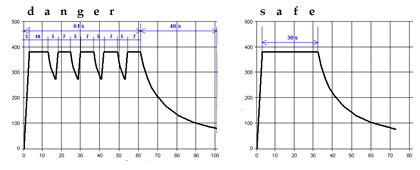
The french alert consists in 5 'periods ' of a signal of about 380 Hz: the first one lasting 10 seconds, followed by four periods each lasting 7 seconds (see the graph just above). The testing then ends at 12h10 with the 'end of alarm' signal, which has one period of a signal of about 380 Hz lasting for 30 sec's (see again the graph above).
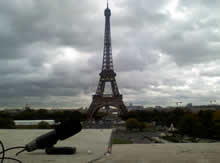 |
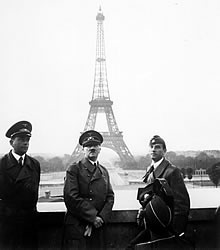 |
Before moving on to Switzerland, Hanna decided to make good use of her surprise at re-finding the sound of the sirens from her youth here in France. She asked a number of people working with sound in Paris to record the testing of the sirens on the first wednesday of october. Hanna told each of us to go and record the sirens at a specific spot in the city, spots that she picked at more or less regular distances along the river Seine (see the Google map below), and with our microphones pointing in a specified direction. It is thus that, despite a hurting throat and feeling somewhat feverish, shortly before noon of wednesday october 1st, 2008, I found myself among tourists and souvenir sellers on the front terrace of the Palais Chaillot, looking out on the Eiffel Tower. And I do not know whether she was aware of this, but she had asked me that I pose the microphone of my MD player at the very spot where 68 years earlier the man who, in a way, was Hanna's sirens raison d'être, Adolf Hitler, put his arm and hands ... That was when during a visit to the capital towards the end of june 1940 shortly after the french surrender, together with his architect Albert Speer (left) and sculptor Arno Breker (right) he stood on the Palais Chaillot terrace for the shooting of one of the second world war's best known propaganda pictures. That evening, as Speer recounts in his memoirs, the Führer orders his architect to take good care that Berlin will become far more beautiful than Paris, so that "when we are finished in Berlin, Paris will only be a shadow ..." ( *** )
It was cloudy, which may have been the reason that up there on the terrace
the city sounded as if muffled. There was a lot of wind and it was verging
on rain.
At precisely twelve
the sirens came.
One could hear several of them, but with a slight delay, because of their
differing distances to the Palace. Their loud sounding startles a couple
of spanish speaking tourists that were taking pictures of one another,
just to the right from where I am standing. The man walks
up to one of the souvenir sellers, who seems to have hundreds of varied size
models of the Eiffel Tower dangling from his shoulders.
"What
this?" he asks in broken english.
The african salesman grabs hold of two of the bigger models that he is carrying and shoves them in the
tourist's direction.
One is colored silver,
the other is in gold.
"Tower!" he says. "Only ten euros! Ten euros!"
"No ... the sound ..." the tourist goes. "What is sound? It is ... alarm !?"
The souvenir seller shrugs his shoulders. "Ten euros," he insists, "and give you one for free! Beautiful!"
...
One hundred and one seconds have passed, and the sirens are silent again.
The tourist looks around him, and sees that nobody seems to bother or pay
any attention. He walks back to his companion. They make another picture,
and another one. Then they head towards the stairs.
A little later the sirens signal that all now is safe.
...
This Google map shows each of the spots where Hanna asked people
to record the sirens test in Paris at noon, wednesday october 1st, 2008.
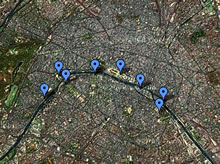 She intends to assemble all the recordings made in a sound installation,
that provisionally is entitled: "Between the Sirens". [ ... ]
She intends to assemble all the recordings made in a sound installation,
that provisionally is entitled: "Between the Sirens". [ ... ]
The total number of civil defense sirens in France hardly exceeds the number
in use in the Netherlands. It therefore is obvious that not everywhere
in France sirens have been installed. Most of the big cities are covered,
though, and subject to the monthly roar of the sirène du mercredi midi.
In the city of Marseille, ever since march 2003, artists make good use of
this recurring and loud urban sonic event, to mark the time for a performance
- a concert/play of twelve minutes, with and between the sirens; tuned for
and with the city - on the square in front of the Opera, by varying
performers from different disciplines: Sirènes et Midi Net it is
called. That's marvelous, I think.
- next: Light budget, heavy thinking -
notes __ ::
(*) Emily Ann Thompson - The
Soundscape of Modernity: Architectural Acoustics and the Culture of Listening
in America (1900-1933) (MIT Press, 2004), p. 139 ... [
^ ]
(**) This in turn led me to a WikiHow page
that had as its title: "How
to behave in a School Lock Down" It specifically concentrates on 'steps',
'tips' and 'warning' in case there is someone (the shooter) going
around your school emptying a loaded gun. I thought I'd mention here one
of the 'tips' : "Use Creativity" ... [
^ ]
(***) Albert Speer - Inside
the Third Reich, p. 172. MacMillan, 1970 . [
^ ]
tags: Berlin, Paris, sirens
# .278.
comments for Hanna's Sirens ::
|
Comments are disabled |
Read about Berlin on the SoundBlog:
(august 4, 2022) - Berlin: Zero Cohesion (3)
(july 24, 2022) - Berlin: Zero Cohesion (2 = ©)
(july 11, 2022) - Berlin: Zero Cohesion (1)
(november 11, 2021) - A Berlin Reader
(august 05, 2011) - (I can't get no) Immediate Satisfaction (Diktat in Berlin_iii)
(july 31, 2011) - 'Kommt raussi!' (Diktat in Berlin_ii)
(july 29, 2011) - 'Where ist Ausland?' (Diktat in Berlin_i)
(february 07, 2009) - « Mok mok jaha für das kleine in Berlin (Tuned City, Berlin_vi)
(december 23, 2008) - « das kleine, Intiem » (Tuned City, Berlin_v)
(december 08, 2008) - un-Tuned City (foundtaping in Neukölln) (Tuned City, Berlin_iv)
(november 12, 2008) - Neurosen der Präzision (Tuned City, Berlin_iii)
(november 07, 2008) - Cake & Coffee (Tuned City, Berlin_ii)
(october 29, 2008) - Light budget, heavy thinking (Tuned City, Berlin_i)
(october 12, 2008) - Hanna's Sirens (Tuned City, Berlin_o)
(july 01, 2007) - dinges (Back to Berlin, iii_3)
(april 25, 2007) - Fluxissage
(april 12, 2007) - reek or (Back to Berlin, iii_2)
(april 08, 2007) - i feelt (Back to Berlin, iii_1)
(march 07, 2007) - found tapes (Back to Berlin, ii)
(february 27, 2007) - "Bo tuny te..." (Back to Berlin, i)